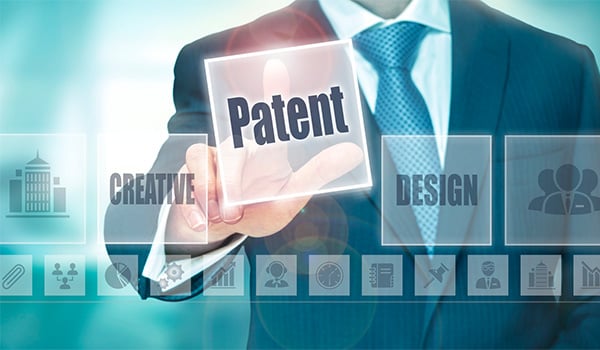03-28-2023 |
What is "Virtual Patent Marking" and Does It Make Sense for Your Business?
By: Christopher Proskey

Have you ever seen a product with the words “Patented” “Patent No.” Pat. No.” or similar language printed on it? If you have, you have seen an example of patent marking. The purpose of patent marking is to provide notice to the public that the product is patented.
A patent owner is not required to mark a product as “Patented.” However, there are many benefits to marking your products.
Marking your products with your patent numbers informs your customers, and perhaps more importantly your competitors, that the product is indeed patented. This can have a chilling effect on potential infringers. Marking your products as patented also serves a marketing function and supports the perception of value and innovativeness of the product.
Perhaps most importantly, consistently marking your products as patented can affect the damages you could recover in the event someone infringes your patent. That is, if you consistently mark your products this puts the world on what is called “Constructive Notice” that your product is patented. That means that any infringer should have known that the product was patented (because the product itself says “Patented”) and therefore the patent owner can get damages starting on the date of infringement. If a patent owner does not mark their products, they can only recover damages for infringement that occurs after the patent owner sends a letter to the infringer informing them of their patent rights.
Without question, if you own a patent or patents, you should “mark” your products.
So How Do You “Mark” Your Products:
For decades, 35 U.S.C. § 287(a) required patented products to be marked as patented by physically marking products themselves or their packaging with the applicable patent number(s).
This meant that patent owners were required to put the exact patent numbers directly on the product itself or its packaging. This can be accomplished by any of the following language:
- “Patented 1,234,567”
- “Patent No. 1,234,567”
- “Pat. No. 1,234,567”
- Or similar language.
This “Actual Marking” or “Physical Marking” process certainly was and is workable in most cases. However, in many cases actually marking the products with the applicable patent numbers can be quite burdensome.
“Actual Marking” or “Physical Marking” is very difficult when a client has a large and/or rapidly growing patent portfolio. Sometimes the patent numbers cannot fit on the product or the packaging. In addition, every time a new patent comes out, the product, labels or packaging must be changed. From a practical standpoint, this is quite burdensome.
“Actual Marking” or “Physical Marking” is also very difficult when a client has a large number of products or models. Different products or models can have different patents that protect them. From a practical standpoint in the manufacturing process, it can be difficult to make sure the proper patent numbers are applied to the appropriate product or model.
It can take a lot of time, effort, and expense for manufacturers to ensure their products are properly marked. Therefore, Congress amended § 287(a) in order to save costs for manufacturers and to facilitate effective marking of small products.
What is Virtual Patent Marking?
The Leahy-Smith America Invents Act (AIA) was signed into law in 2011 that made amendment to 35 U.S.C. § 287(a) that allows patentees to “virtually” mark their products instead of “actually” or “physically” marking them.
To virtually mark a product, a patent owner must mark the product itself or to the packaging for the product with the word “patent” or “pat.” followed by an Internet website address. At the listed Internet website address, the patent numbers are listed that apply to the product. Therefore, when a consumer buys the patented product, they can go to the website shown on the product or its packaging and see all of the patents that are associated with that product.
For example, a company could mark their patented product with one of the following markings; “Patent www.company.com/patents” or “pat. www.company.com/patents”.
Benefits of Virtual Patent Marking:
The use of a website for virtual marking allows companies the ability to update their patent information for the public without making any expensive modifications to their manufacturing processes. It also allows manufacturers to produce one patent sticker or label that applies to all of their patented products. Further, virtual marking can provide a real-time and complete list of patents associated with each product to help promote the general public’s access to patent information.
Drawbacks of Virtual Patent Marking:
While virtual marking provides a streamlined method of efficiently putting the public, and any potential infringers, on notice of the patents associated with a product, the system may be burdensome to maintain. Companies will need to commit to keeping the website they choose updated with patent information related to each product or risk the public and potential infringers not being on notice that the products are patented.
Examples of Virtual Patent Marking Website:
After a company has committed to maintaining a website for virtual patent marking, they must develop the website. These websites can be relatively simple. For example, the website could include a short notice stating that the products listed are protected by patents and a disclaimer that the list may not be all-inclusive. Next, the website should include an updated list of the company’s products and each patent that applies to each product or model. For example, the company could use the following scheme to create the list.
|
PATENT NUMBER 1; PATENT NUMBER 2; PATENT NUMBER 3; Other Patents Pending |
|
PATENT NUMBER 4; PATENT NUMBER 5; PATENT NUMBER 6; Other Patents Pending |
For more examples of virtual patent marking websites, please see the below websites.
- www.fitbit.com/global/us/legal/patent-list
- www.nest.com/legal/ip-and-other-notices/patent/
- www.owenscorning.com/patents
- www.arthrex.com/corporate/virtual-patent-marking
- www.totani.co.jp/en/patent.html
If you need further guidance on virtual patent marking or need any other assistance with your intellectual property needs, please contact Christopher Proskey, J.D., M.B.A. at the Brown Winick Law Firm.
Meet the Author:

